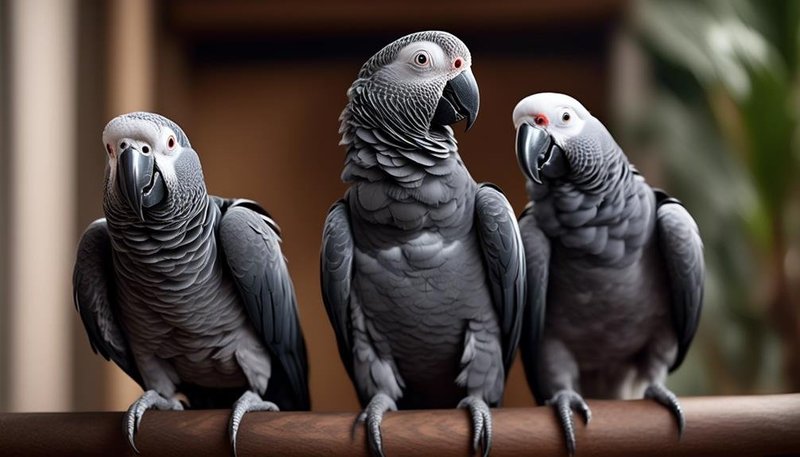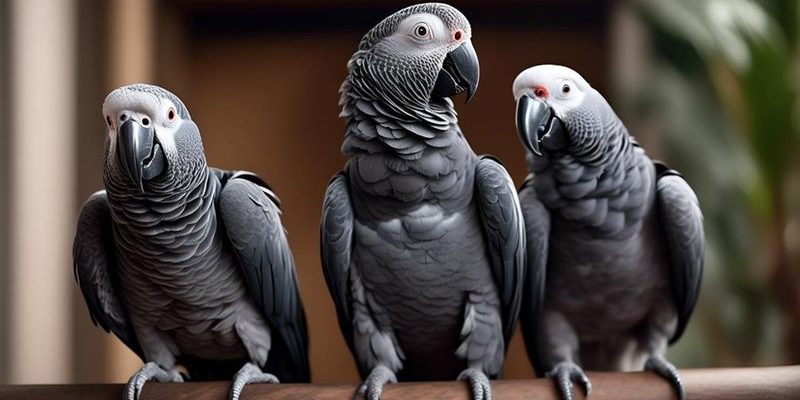
But what truly sets them apart from other similar species? Imagine a vibrant party where everyone has a unique talent—some might dance, while others sing or juggle. In the world of parrots, the African Grey brings a whole different flavor to the mix, especially in comparison to other popular birds like the Amazon parrot or the cockatoo. Let’s explore these differences in-depth, uncovering what makes the African Grey so special.
Physical Differences
The African Grey Parrot is easily identifiable by its distinctive gray plumage and bright red tail feathers. This coloration sets it apart from many other parrots. For example, the Amazon parrot, which is often vibrant green with splashes of other colors, presents a stark contrast. While both species share a medium size, the African Grey generally feels a bit more compact and sturdy.
Another physical feature that stands out is the African Grey’s beak. It’s strong and curved, perfectly designed for cracking nuts and seeds. In comparison, the beaks of cockatoos are more elongated and often have a prominent crest on their heads. Each species’ beak reflects its eating habits—while African Greys prefer seeds and nuts, cockatoos may munch on a wider variety of fruits.
If you’re looking closely, you might also notice the eye color. Young African Greys have dark eyes that gradually lighten to a bright yellow or orange hue as they mature. This is a great little detail that differentiates them from many other parrots, whose eye colors typically remain consistent throughout their lives.
Intelligence and Vocal Abilities
Here’s the thing: African Grey Parrots are among the most intelligent bird species on the planet. They don’t just mimic sounds; they can understand context and are known to have a vocabulary that can rival that of a three-year-old child. Picture having a deep conversation with your feathered friend—it’s not far off with these guys!
In contrast, while other species like the Amazon parrot and cockatoos can also talk, their abilities can vary significantly. For example, an Amazon parrot might repeat words or phrases but lacks the depth of understanding that an African Grey exhibits. It’s as if you’re talking to a clever parrot scholar, while other parrots might just stick to reciting their lines from a script.
This intelligence makes the African Grey particularly engaging, but it also means they require significant mental stimulation. Think about it: they thrive on puzzles, toys, and interactive play. If bored, they might dive into some not-so-great habits like feather-plucking. So, keeping their minds engaged is crucial!
Social Behavior
African Greys are generally more reserved than their more outgoing parrot cousins. When you think of a cockatoo, you picture a lively bird that loves to show off and interact. Cockatoos tend to be affectionate and outgoing, often seeking human attention and interaction. African Greys, on the other hand, might seem more aloof at first. They’re not antisocial; they just take their time to warm up.
This social behavior impacts how you can bond with them. African Greys often require patience and trust-building. They usually bond closely with one person, making love and affection feel very special. In contrast, cockatoos might spread their love around a bit more, enjoying the attention of multiple family members.
Additionally, while both species can experience separation anxiety, African Greys might show it more acutely. Their deep attachment to their owner means that leaving them alone can lead to some dramatic reactions. So, if you’re considering bringing one home, be prepared for a potential drama queen!
Dietary Needs
Let me explain the dietary differences. African Greys have a specific range of dietary needs that can differ from other parrots. They thrive on a balanced diet of seeds, fruits, vegetables, and specially formulated pellets that help ensure they get all their nutrients. Their bodies are particularly sensitive to certain foods, like avocados, which can be toxic to them.
In comparison, Amazon parrots enjoy a more varied diet that might include a wider array of fruits and nuts. They can be a bit less picky than African Greys, who tend to develop preferences and even aversions to certain items. So, if you’re thinking about feeding an African Grey, you’ll need to do a bit of homework to ensure they’re getting the right nutrients.
It’s also important to note that both species can benefit greatly from fresh produce, but African Greys need a well-structured feeding plan to avoid common health issues like obesity. Balancing their meals not only supports their physical health but also their mental well-being. You might find that some fresh fruits and veggies can lead to delightful interactions!
Life Span and Care Requirements
The lifespan of an African Grey can stretch up to 50 years or more with proper care, which is pretty impressive! In comparison, many cockatoos and other parrot species have a slightly shorter lifespan. This longevity means that adopting an African Grey is a long-term commitment. You’re not just bringing home a pet; you’re welcoming a family member for decades.
When it comes to care, African Greys need a specific environment to thrive. They require a spacious cage with plenty of toys and opportunities for exercise. This is where they differ from other birds, like budgies, which can be quite content in smaller setups. African Greys are like fine wine—they need just the right conditions to truly shine and be their best selves.
This lifestyle can be more demanding. You might need to set aside time every day for mental and physical stimulation. If you’re someone who travels often or has a busy schedule, consider whether you can meet their needs before making the leap.
In the grand world of parrots, the African Grey stands out for its intelligence, unique social behavior, and specific care needs. While it’s easy to appreciate how other parrots like the Amazon or cockatoo shine in their own ways, the African Grey is a one-of-a-kind companion that brings a depth of connection and personality.
Whether you’re drawn to their stunning appearance, engaging vocals, or intriguing behaviors, knowing what sets them apart helps you make more informed decisions about bird ownership. After all, adopting a parrot means embracing a new, feathered friend with a whole world of quirks and charm. So, if you’re ready to dive into the adventure of parrot ownership, the African Grey might just be the perfect match for you!

